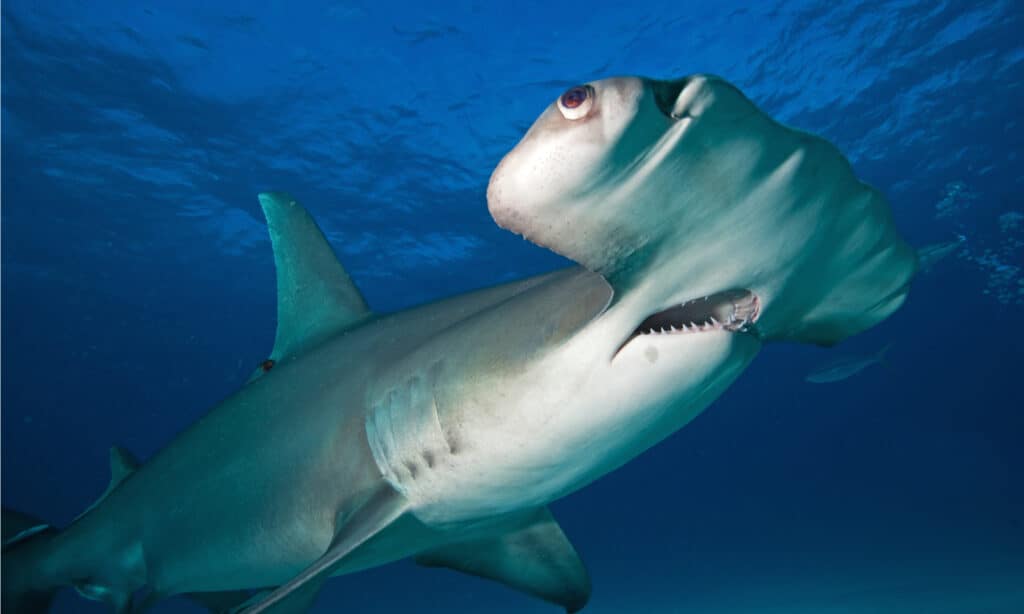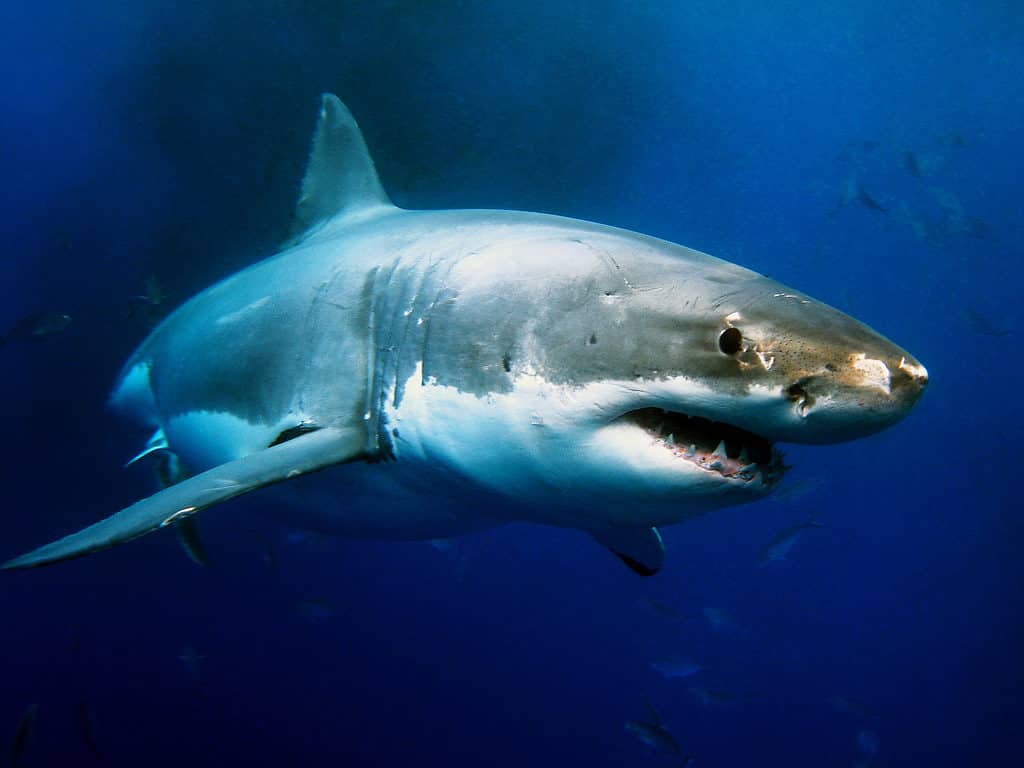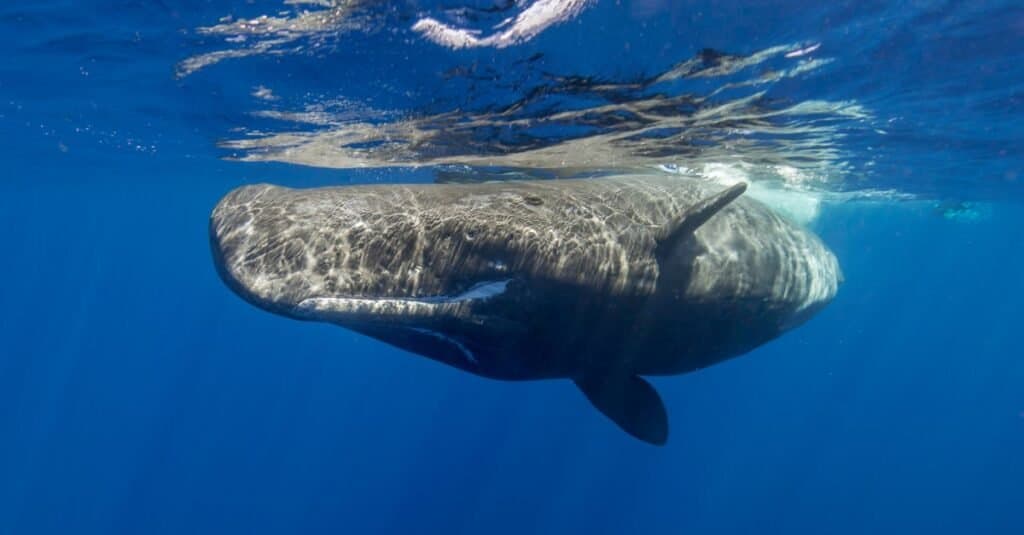Today, two of the ocean’s top predators face off: the largest hammerhead ever vs. a killer whale.
Killer whales, also called orcas, are smart. They use teamwork and expert hunting skills to catch their prey. On the other hand, the hammerhead shark is a solitary hunter whose unique head shape helps them detect prey deep in the sand.
Let’s dive into the ocean’s depths to compare these two species further to see who will survive this epic sea battle.
Overview: Largest Hammerhead Shark

Hammerhead sharks have a head resembling a hammer or a T shape.
©HakBak/Shutterstock.com
The largest hammerhead shark ever recorded was 14 feet 7 inches long. Which is still less than half the length of a 30-foot orca.
Hammerhead sharks have a head resembling a hammer or a T shape. The odd special shape helps enhance their vision and overall sensing abilities. The T-shaped head has electrical sensors, leading them to prey. They can even sense ocean critters hiding in the sand.
There’s more than one type of hammerhead; there are three. First, you have the great hammerhead. Next, there’s the scalloped hammerhead. And finally, we have the smooth hammerhead. All three species are challenging to study because of how much they move around. Researchers sometimes use ultrasonic transmitters and temperature sensors to analyze their movements and habitat preferences.
Hammerhead sharks have two movements: constrained near the island and dispersive offshore. That means near the island; they stick to one location for the most part. But hammerheads move around more sporadically once they venture offshore, chasing their meals. Sometimes hammerheads also use vertical movements when foraging.
Hammerheads are picky about the location and depth of their waters. They prefer the up-current habitat and the top of the thermocline. These spots help them stay clean and regulate their body temperatures. Hammerheads can even swim near the surface to get a healthy tan. Sun tanning helps hammerheads when they’re swimming in the clear pelagic waters, where UV light penetrates more deeply.
The killer whale might be up against more than one shark. Scalloped hammerhead sharks like to swim in big groups. During the day, they stick together. They go out into the open water at night to look for food. The currents and tides guide their movements and determine their hunt’s success.
Hammerhead Shark Vision: 360 Panoramic View

The eyes of Great Hammerhead Sharks sit on the edge of their mallet-shaped heads, they have excellent eyesight and a 360 view of their surroundings, making them skilled hunters.
©Martin Prochazkacz/Shutterstock.com
There’s no hiding from a hammerhead shark. Their T-shaped head sees everything. Just how much can these ocean dwellers spot?
Shark researchers did a study to find out how much hammerheads see in the front, up, and down, and the results were impressive. These sharks can see in a big circle around their head. They have a 360 panoramic view. The view is thanks to the overlapping line of vision from their wide head shape.
Hammerhead sharks are also known as masters of light adaptation. They can quickly adapt their eyes to changes in light. The shark’s adaptation is helpful when the ocean’s light changes, often in clear pelagic waters. It also helps with movement. In the largest hammerhead ever vs. a killer whale battle, the shark would be able to keep its bearings.
Fast species have to be able to adapt to quick changes in light. When a hammerhead is going 25 mph, they need to be able to identify its surroundings and spot dangers. Dangers like a humongous killer whale swimming its way!
However, no matter how fast they go, the hammerhead won’t be able to win in a race against an orca. Hammerheads top out at 25 mph; killer whales can go 28 mph or more.
Chance of Ocean Encounter: Largest Hammerhead Ever vs. A Killer Whale

Killer whales are one of the most widely distributed marine mammals.
©slowmotiongli/Shutterstock.com
What are the chances of the largest hammerhead ever vs. a killer whale battle happening? Would they even cross paths in their natural habitats? The odds of these two animals being in the same area are high.
Killer whales are one of the most widely distributed marine mammals. They live from the Arctic to the Antarctic and in both coastal and offshore waters. And hammerhead sharks live in temperate and tropical waters but may move to cooler waters during the summer.
Hammerheads like hanging out at seamounts where they can find food. A killer whale might be hunting for the same fish, and that’s when things could heat up. Killer whales have a reputation for killing sharks.
Orcas Overpower Hammerhead and Great White Sharks
Working as a team, two killer whales, Port and Starboard, hunt and eat great white sharks. They kill the large sharks by expertly removing their liver. Researchers report the liver removal technique as “surgical”. Why take out the liver? It’s tasty! Plus, the liver is the most nutritious part of the shark; it’s full of healthy oils.
There was also a possible hammerhead vs. killer whale sighting in the Galápagos Islands. The sharks were later identified as scalloped hammerheads. Three killer whales were observed near a dead female hammerhead shark. Now, the whales could be innocent. No one saw them kill the shark, but it’s they likely did. The whales seemed to be intrigued and were chasing around a pup.
The dead shark had been pregnant, was startled or stressed by something, and gave birth prematurely. The killer whales chased the premature pup around before leaving the scene. The whales didn’t eat the sharks. They were likely practicing hunting skills.

Working as a team, two killer whales,
Port and Starboard
, hunt and eat great white sharks.
©iStock.com/Whitepointer
Killer Whales Attack Sperm Whales
A herd of around 35 killer whales attacked nine sperm whales off the coast of central California in 1997. And in typical orca fashion, the attack was well coordinated. Using groups of four to five pod members, the whales took turns attacking.
The sperm whale put up a big fight and even killed one of the killer whales and wounded others. But ultimately, the sperm whale lost the battle. They were outnumbered and out-skilled by the expert killer whales.

A herd of around
35 killer whales attacked nine sperm whales
off the coast of central California in 1997.
©wildestanimal/Shutterstock.com
Overview: Killer Whale
Killer whales sometimes kill things for practice. Some speculate they kill things for fun. They have 45 sharp teeth that are designed to rip prey apart. And they have to rip their prey because these whales never chew their food. They swallow smaller prey whole and eat larger prey in chunks. Some of their favorite foods include seals and schools of herring.
Tracing Their Love for Marine Mammals
The killer and false killer whales are the only whales that hunt other marine mammals. And now it looks like their dietary preference has deep roots.
Recently, scientists discovered a new extinct species related to killer whales. It’s called Rododelphis stamatiadisi. They determined what the ancient whale ate by analyzing five fish bones in its stomach. The results? Even millions of years ago, the killer whale lineage was eating marine mammals.
Killer whales have three different ecotypes. Transients are killer whales that eat other marine mammals, like seals. Residents eat fish, especially salmon. The offshore ecotype is mysterious but appears to be fish eaters who enjoy the occasional shark.
Killer Whales Whisper to Fool Prey
Killer whales have special calls they use to communicate. But they have to be careful. If they’re not smart, the prey will hear them and run away. This study explores how the superior hearing of mammalian prey affects the vocal behavior of transient killer whales. In other words, do killer whales know to whisper when prey’s around?
Researchers recorded pulsed calls and behaviors of resident and transient killer whales in British Columbia and southeastern Alaska. They found that transient killer whales produce pulsed calls less frequently than resident killer whales that feed on fish. Transient whales only make calls after a successful kill. It’s reminiscent of how a wolf calls out with a howl after making a kill. The howl lets other pack members know the hunt was successful.
Whale Tails Go “Thud” to Stun Fish
Tail slapping is a technique witnessed in big predators like sharks, billfish, dolphins, and killer whales. The hunting technique lets them catch small, quick prey by disorienting them. Norwegian and Icelandic killer whales always use this technique to catch Atlantic herring.
It’s not just the impact of the nine-foot-long tail that disorients fish. It’s also the sound. The slaps make a loud thud-like sound, which throws the fish off their game. This allows the focused hunter to swoop in and eat them rather than chase them around.

Killer whales have special calls they use to communicate.
©iStock.com/cullenphotos
Killer Whales: Masters of Hunting and Stealth
These whales are speedy swimmers. They could easily catch up to the hammerhead with a 28 mph speed.
Along with being fast, killer whales are also stealthy. They have black backs and white stomachs to stay hidden. From above, their backs blend in with the dark water below. This makes it difficult for their prey to see them. And from below, their big white bellies blend in with the surface light.
Baby Making Showdown: Hammerhead Sharks vs. Killer Whales
Killer whales are one of the longest-living marine animals on Earth. Some killer whales can live up to 90 years old, seeing a lot over their lifetime. Females give birth to calves every 5 years during the fall and winter. Baby killer whales are first seen during summer and reach adulthood around 10 years.
What about sharks? Some species of hammerhead sharks are viviparous, which means that they give birth to live young. Other species are oviparous; they lay eggs that hatch outside the mother’s body. And sometimes, on rare occasions, females don’t even need the males to have a baby.
And then there’s the hammerhead shark that had a virgin birth. The shark, at the Nebraska aquarium, gave birth without mating. How? They had a baby using parthenogenesis, which allows for asexual reproduction. Reproducing with only one member of the sex. Sharks typically require both sexes to mate and produce offspring. However, in some cases, females can reproduce independently.
Before recorded instances like the Nebraska aquarium incident, scientists hammerheads giving birth without a mate were storing sperm. Now we know it’s even more special; they can make babies with just one female shark. A feat the mighty killer whale has yet to pull off.
Who Wins?
The killer whale wins. And for a lot of reasons. One of the biggest is that these apex predators already target sharks, like the great white. They squeeze out the shark’s liver like toothpaste. Other times, they suffocate sharks by bringing them to the surface. And if they’re feeling feisty, the whale can ram the shark in the gills. There are also accounts of killer whales fighting large sperm whales and winning.
Another one of the advantages the killer whale has is its pod. During the epic orca vs. sperm whale battle, the killer whales had the power of numbers. There were 35 of them, and they executed an expert take-down of one of the ocean’s biggest creatures.
Even one-on-one, the killer whale will beat the hammerhead shark. They could probably take down three to five hammerheads. They’re just that strong.
Another thing to consider is movement and hunting strategies. The way orcas hunt vs. the way hammerheads forage are completely different. Hammerheads are excellent survivalists and can find food hiding in the sand. But they’re not forceful hunters like the whale. No matter how hard they try, the hammerhead won’t be able to inflict enough damage to overpower the big, strong whale.
When it comes to the largest hammerhead ever vs. a killer whale, the win goes to the competitor with the word killer in their name. Hammerheads are fascinating creatures, but they’re no match for the sharp-toothed, tail-slapping whale that can weigh over 8,000 pounds. The killer whale is the ultimate winner.
The photo featured at the top of this post is ©
Thank you for reading! Have some feedback for us? Contact the AZ Animals editorial team.






